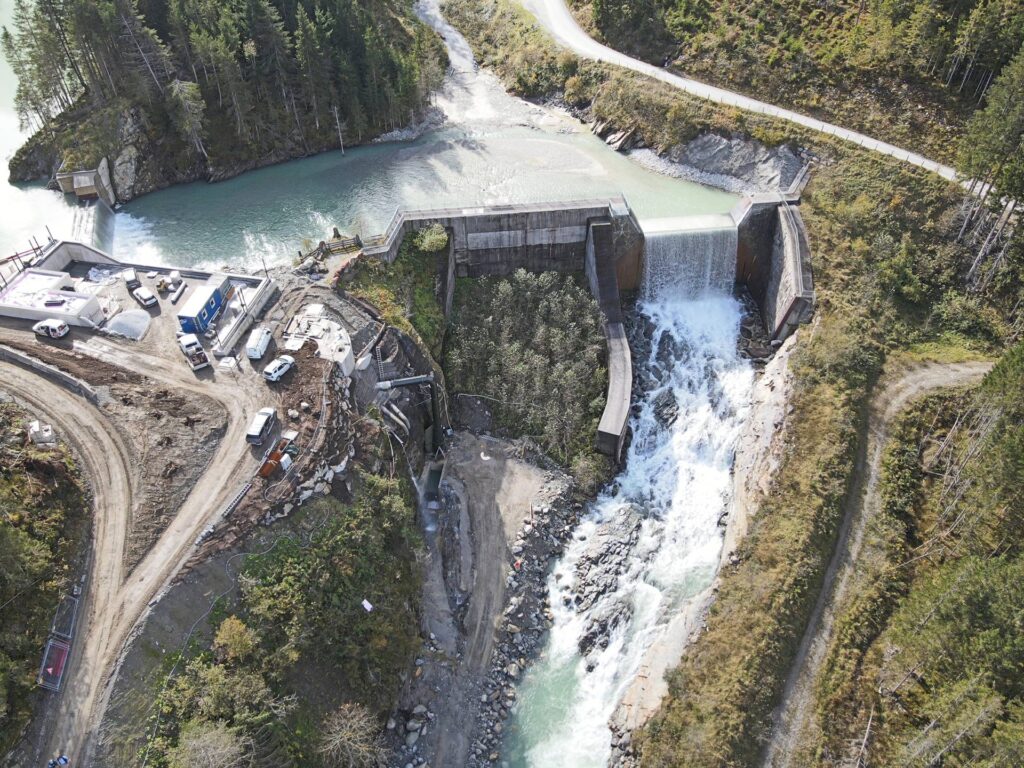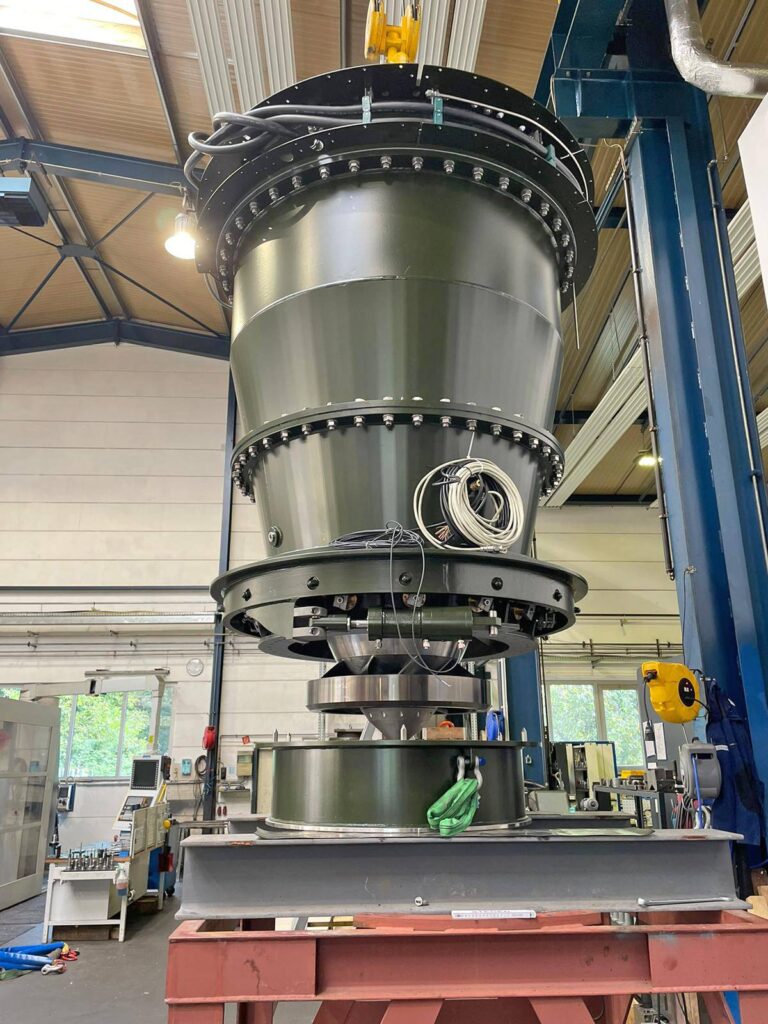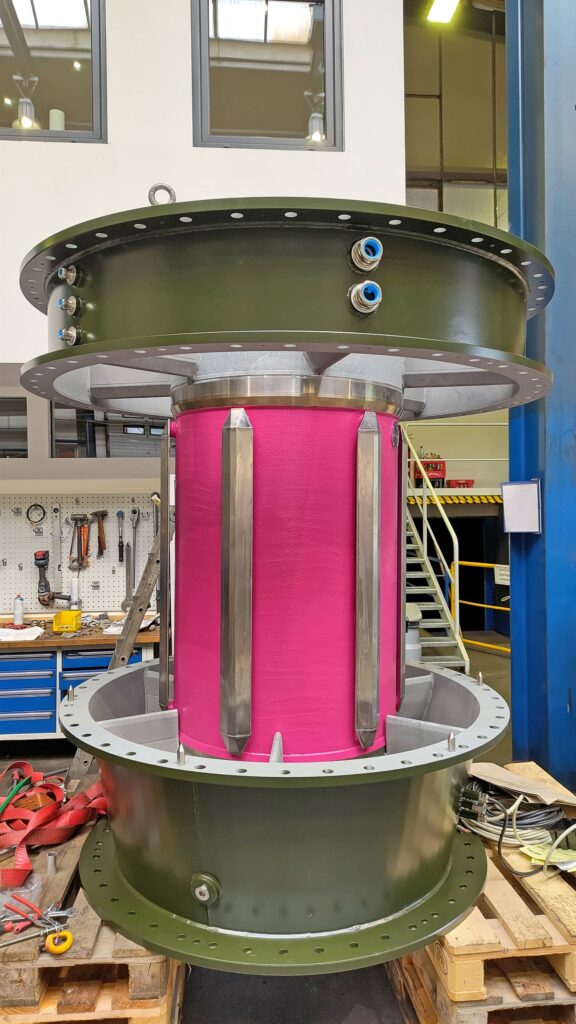Impressive innovative technology at newresidual hydropower plant in Austria
Salzburg AG, an Austrian energy supplier, is currently constructing a new small hydropower plant on the Obersulzbach River in Neukirchen am Großvenediger in Austria to go into full operation this year. Three turbine variants are to be used for electricity generation at the Sulzau power plant. The residual water turbine, the smallest of these, is particularly technically innovative. The entire DIVE Turbine-Generator-Unit was installed in a vertical 20-metre penstock. The system was hydraulically optimised for this purpose to generate around 1 million kilowatt hours annually.

© Salzburg AG
The Sulzau power plant project site is located in the idyllic Obersulzbachtal valley in Austria‘s Pinzgau region. Construction work has been underway since April 2023 and the plant is scheduled to go online punctually in the first half of 2025. Salzburg AG and Lichtgenossenschaft Neukirchen are jointly investing around 23.5 million euros in a plant expected to supply around 18.4 gigawatt hours of clean electricity in an average year. The new green-energy set-up is one of the smaller of such infrastructures in the Salzburg energy supplier‘s hydropower plant portfolio. However, technologically, it has a lot to offer – with a larger-scale Francis turbine, and a smaller 6-nozzle Pelton turbine, installed in the powerhouse. The gross head of the main station is around 78 metres, and the Francis turbine is capable of processing large volumes of water over extended periods, as is the case when the snow melts or there is prolonged rainfall. In contrast, the Pelton turbine offers greater flexibility, can adapt to fluctuating water volumes at consistently high efficiency levels, and forms an ideal combination with the larger Francis turbine. Together, the two turbines produce a bottleneck output of around 5.6MW, and are supplemented by a third turbine that doesn’t operate in the powerhouse.

© DIVE
Green electricity from residual/ecological flows

© DIVE
The third turbine is located in the water intake area and is served by two solid dam walls built years ago by the torrent and avalanche control authority. The intake structure for the new power station was built at the Alte Blauseesperre barrier to utilise the drop of around 21 metres – at the precise location where the diversion channel feeds back into the Obersulzbach. The power plant planners wanted to take advantage of this height difference for electricity production, but needed to establish which technical solution could be used to achieve this effectively and economically. The solution was the latest DIVE-COAX turbine, which was developed especially for this purpose by the German turbine specialists DIVE-Turbine. Generally speaking, the DIVE-Turbine is a vertical-flow, speed-controlled propeller turbine whose impeller is directly connected to the generator via the turbine shaft, and permanent completely submerged. “The DIVE-Turbine can process water volumes from less than 200l/s up to 2,200l/s, depending on the inflow”, says Thomas Friedrich, Salzburg AG’s Project Manager, explaining the flexibility of the turbine and the choice of this type of turbine. The benefits in favour of DIVE-Turbine technology were its low construction costs and comparatively high annual power output. Another benefit for the operator is that it can remain in operation, even when the water supply is minimal, since low flow volumes – as a result of extremely cold temperatures – can lead to ice build-up when a turbine is switched off.
Uninterrupted underwater operation
The central consideration when designing the residual hydropower plant was to ensure that the pressure pipe with the DIVE-COAX was seamlessly integrated into the surrounding scenery and natural rock near the Alte Blausee barrier. “We couldn’t install a building for the turbine in the riverbed, so it was clear from the outset that the unit would have to be installed in the free-standing pipeline in the flooded area,” says Christian Winkler, Sales Manager for DIVE Turbinen GmbH & Co. KG. He explains why, technically, the DIVE-Turbine is particularly suited to this mode of operation: “DIVE-Turbine‘s patented machine design is ideally suited to this type of application. It features a compact, combined bearing unit for the turbine and generator, as well as a maintenance-free DIVE-sealing. These features ensure the machine is permanently submersible and resistant to flooding, as well as being runaway-proof.”
The German hydropower specialist provided the turbine-generator unit, the penstock, and the electrical infrastructure, including the innovative inverters for variable-speed operation. Installation work was carried out in September and October of 2024.

© DIVE
Project-specific adaptations required
Customisation of the site solution by DIVE engineers was crucial to successful project implementation. In addition to special pipe routing adaptations, the engineers were also required to develop the hydraulic design in-house at DIVE via 3D CFD methods. As Christian Winkler recalls, “When adapting the machinery to site conditions, we emphasised both optimum efficiency at the nominal point, and the achievement of excellent part-load performance. The goal was to maximise overall yearly performance – and we succeeded.”
The DIVE-Turbine is basically a double-regulated machine unit with a fixed-blade impeller. Double regulation is achieved via the adjustable guide vanes and speed variation options. The hydraulic design provided for a diagonal turbine – optimised for variable-speed operation with fixed impeller blades and an outer ring. DIVE refers to this as a HAX impeller due to the semi-axial flow. The machine itself is a COAX turbine, since the flow through the guide vane is coaxial. This set-up allows the DIVE-Turbine to be operated effectively across a wide load band – a key quality, as it is a necessity at the Sulzau residual water power plant. The turbine is commonly operated in winter, even when flow volumes are well below 10 per cent of the standard nominal flow rate.
Negligible damage from debris

© DIVE
Another reason the DIVE-Turbine is ideally suited to the location on this rushing Austrian mountain river is its all-round resistance to abrasion caused by debris. This is due to its geometry, the overall hydraulic design and the materials used. Larger particles in particular cause very little damage to the impeller whose excellent mechanical integrity is essentially due to its having been manufactured from solid steel blank. “After machining, this particular impeller was subjected to a special hardening procedure, necessitated by the fact that the Obersulzbach River also carries large volumes of glacial erosion particles known to increase the risk of abrasion,” explains project manager Felix Frey.
Inverter enables variable speeds
DIVE-Turbines also paid close attention to the planning of the project-specific electrical infrastructure, particularly the inverters required for variable-speed power plant operation. Explaining the details, Sven Hermann, Head of Electrical Engineering states: “Obviously, the generation of specific speed set points is important for this type of application. This was implemented while keeping a keen eye on hydraulic and electrical stability. It was essential to avoid any mechanical or electrical resonance during regenerative feedback via sensorless speed control,” Hermann also pointed out that complexity for customers was reduced in favour of control system robustness.
Speed control is facilitated by a permanent magnet generator, driven gear-free by the DIVE-Turbine impeller and the electronic converters. Inverter operation of the DIVE-Turbine enables electricity to be generated from as little as 5% of nominal flow; a key reason for the excellent suitability of this solution on a dynamic alpine river.

© Salzburg AG
Powerful 360-kW power pack
The German hydropower specialists installed a DIVE-COAX Turbine with a runner diameter of 650mm on the Obersulzbach. The unit is specifically designed for use with residual/ecological flows ranging from 220 l/s to 2.2 m³/s, with a head of 21.05 m. The residual water turbine achieves a maximum expansion capacity of 360kW. As the plant uses a completely enclosed pipe system, and the turbine and generator form a compact gearless unit within, the ensemble operates at very low noise and vibration levels. In total, the residual water hydropower plant alone generates around 1GWh of renewable electricity in a standard year; enough to serve around 400 Austrian households.
The residual water turbine was commissioned successfully in November 2024, and the main power plant was completed on schedule in the spring of this year. Altogether, the main power plant and the new residual power plant will supply Salzburg AG with enough electricity to power 5,000 households.